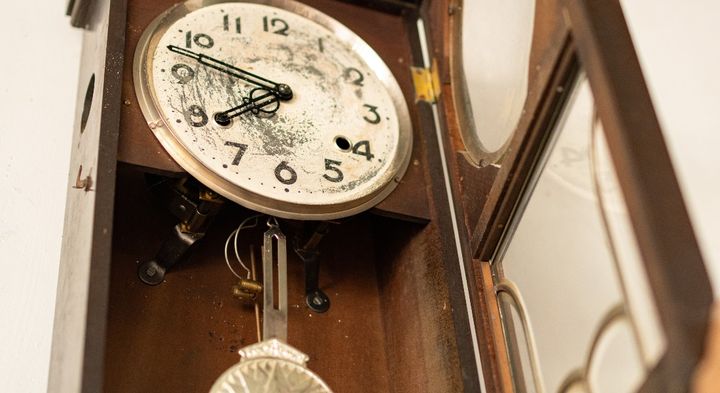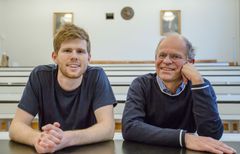New understanding of the body’s cells: Synchronise like pendulum clocks
Researchers from the University of Copenhagen have discovered that old grandfather clocks and human cells have a central thing in common: They move in synchronisation. This strengthens the performance of our cells and makes them better at combating diseases This new knowledge is an important step towards understanding and preventing diseases such as cancer and diabetes and has been published in the prestigious journal Cell Systems.

In 1655, the Dutch mathematician and inventor of the pendulum clock, Christian Huygens, discovered something strange. If he hung two identical pendulum clocks next to each other, they would always synchronise within 30 minutes.
New research from the Niels Bohr Institute at the University of Copenhagen now shows that the phenomenon observed in old grandfather clocks and cuckoo clocks also applies to the cells of the human body. For, like a symphony orchestra, the cells synchronise with each other in order to perform the vital tasks of producing energy, transporting oxygen or fighting diseases more efficiently.
“We’ve discovered that, in the same way as the pendulum clocks in Huygens’ experiments beat in synchronisation, the cells of the body also work in uniform beats. This helps them achieve a higher degree of collaboration, enabling them to perform their tasks better and more efficiently,” says Postdoc Mathias Heltberg, who has created the physical and mathematical models behind the experiments, together with his colleague Prof. Mogens Høgh Jensen and PhD student Malthe Skytte Nielsen.
More superpowers in cells when working together
Translated into the world of a cell, the oscillations from the clock correspond to the increase and decrease in the quantity of proteins and other molecules that the cell alternately produces more or less of to perform different tasks in the body.
To examine whether the cells turn their production up and down in step with each other, the researchers created an artificial oscillation using two different transmitters that were injected into yeast cells. One of the transmitters was alcohol, and the other was a transmitter that imitated an infection and would therefore trigger the immune system of the cell.
Specifically, the researchers examined how the super protein NF-kappa-B fluctuates up and down. This is a protein found in most of the body’s cells and it plays a key role in countless processes. For example, the super protein is responsible for kickstarting the immune system and turning up the production of itself when the body is exposed to an attack from a bacterium.
Here, the study showed that the concentrations of the super protein were higher in the cells when they worked synchronously than if they did not.
“We had two hypotheses in advance. Either the two transmitters that hit the cell at the same time would throw it into complete chaos where it no longer functioned. Or the cell would control itself even better and synchronise its response and work in step with the other cells, which was what happened,” explains Mogens Høgh Jensen.
Future prevention of cancer and diabetes
According to the group of researchers at the Niels Bohr Institute, the new discovery is particularly interesting because the fluctuations in the cell play a central role in our understanding of how the cell is controlled. A greater understanding of these processes can pave the way for new methods for treating serious diseases in the future.
“If we can understand the fluctuations, we will also know more about what goes wrong when defects in the cells lead to the body’s control systems breaking down and causing cancer or diabetes. Therefore, our results are an important step towards understanding how the body controls its cells, so that we can later develop biochemical tools that can prevent diseases,” says Malthe Skytte Nielsen.
Even though the researchers have now become a little wiser about the smallest building blocks of the body, there is still much that we do not know about the inner life of the cells. For example, it is still not known exactly how the cells communicate with each other and start working in step.
“It’s my big dream to understand how cells, that is living organisms without a brain, can transmit and translate signals and regulate themselves. This is one of the biggest questions of science, and one that I’ve so far dedicated most of my research career to,” says Mathias Heltberg.
The study has been conducted in collaboration with researchers from Peking University who have conducted experiments on yeast cells based on the mathematical and physical models made by Mathias Heltberg, Malthe Skytte Nielsen and Mogens Høgh Jensen.
Kontakter
Mathias Heltberg
Postdoc, PhD
Niels Bohr Institute
University of Copenhagen
Mobile: +45 26191889
Email: mathias.heltberg@nbi.ku.dk
Malthe Skytte Nielsen
PhD student
Niels Bohr Institute
University of Copenhagen
Mobile: +45 28901902
Email: malthe.nielsen@nbi.ku.dk
Mogens Høgh Jensen
Professor, Dsc
Niels Bohr Institute
University of Copenhagen
Mobile: +45 28755371
Email: mhjensen@nbi.ku.dk
Michael Skov Jensen
Journalist and Team Coordinator
Faculty of Science (SCIENCE)
Mobile: +45 93 56 58 97
Email: msj@science.ku.dk
Billeder
Følg pressemeddelelser fra Københavns Universitet - Det Natur- og Biovidenskabelige Fakultet
Skriv dig op her, og modtag pressemeddelelser på e-mail. Indtast din e-mail, klik på abonner, og følg instruktionerne i den udsendte e-mail.
Flere pressemeddelelser fra Københavns Universitet - Det Natur- og Biovidenskabelige Fakultet
Ancient grain has huge climate potential and could play a key role in Europe’s future8.4.2025 11:41:23 CEST | Press release
Sorghum is one of the world’s oldest grains and possesses many traits that can benefit food security, climate resilience, and biodiversity. However, the mechanisms behind these traits have long remained a mystery to researchers, which has hindered efficient cultivation. Now, a new technique and a biobank - developed in collaboration with the University of Copenhagen - have made research and breeding possible at an unprecedented pace, paving the way to an effective crop in both the Global North and South.
Ældgammel kornsort har kæmpe klimapotentiale og kan blive vigtig i Europas fremtid8.4.2025 11:11:07 CEST | Pressemeddelelse
Sorghum er en af verden ældste kornsorter og har mange egenskaber, der kan gavne fødevaresikkerhed, klima og biodiversitet. Mekanismerne bag egenskaberne har dog været en gåde for forskerne, og det har stået i vejen for en effektiv dyrkning. Ny teknik og biobank, udviklet i et samarbejde med Københavns Universitet, åbner nu for forskning og forædling i turbogear. Det kan bane vej til en effektiv afgrøde i både det globale nord og syd.
Core samples from Greenland's seabed provide first historical overview of plastic pollution21.3.2025 10:52:58 CET | Press release
By coring the seabed at 850 m water depth in Disko Bay off Greenland's west coast, researchers from the University of Copenhagen have obtained the first historical record of plastic pollution in Greenland. The new data suggest a link to local socio-economic development and represent a step towards developing a common method for analyzing and mapping global microplastic pollution.
Kerneboringer i Grønlands havbund giver for første gang et historisk overblik over plastikforurening19.3.2025 09:41:25 CET | Pressemeddelelse
Ved bore kerneprøver fra havbunden - i Diskobugten ud fra Grønlands vestkyst - har forskere fra Københavns Universitet opnået den første historiske optegnelse af plastforurening i Grønland. De nye data fra 850 meters dybde tyder på en forbindelse til den socioøkonomiske udvikling lokalt, og er et skridt i retningen af fælles metoder til at analysere og kortlægge global mikroplastforurening.
Popular cooking cheese made with peas yields same taste and texture18.3.2025 08:47:00 CET | Press release
A significant amount of the milk used in a popular cooking cheese can be substituted with plants, all while maintaining its taste and texture. Researchers from the University of Copenhagen have demonstrated this by creating a hybrid version of paneer, a popular South Asian cheese, with twenty-five percent pea protein. The result is a solid step towards more sustainable dairy products with nutritional benefits.
I vores nyhedsrum kan du læse alle vores pressemeddelelser, tilgå materiale i form af billeder og dokumenter samt finde vores kontaktoplysninger.
Besøg vores nyhedsrum
